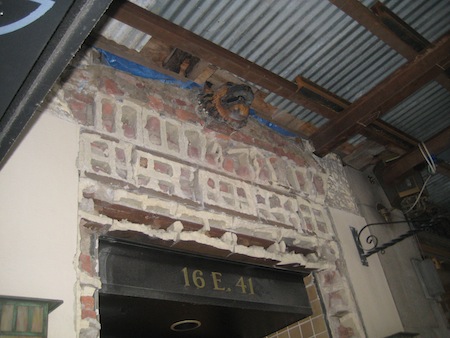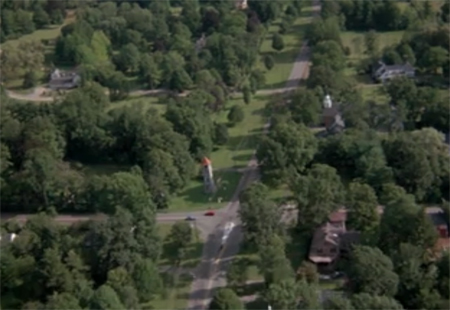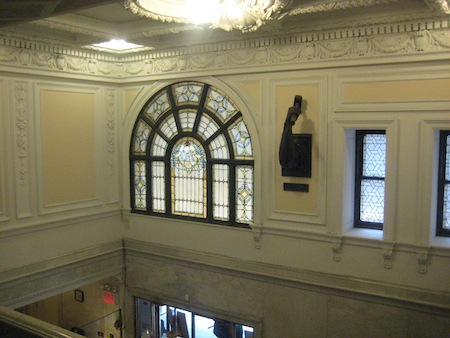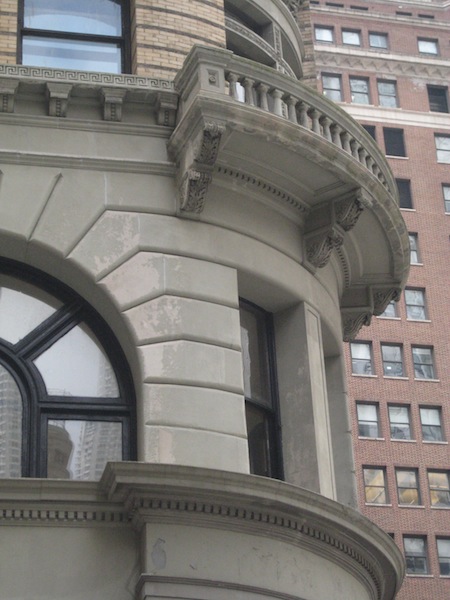This, the first post here in almost a year, will be short: a first draft of the book has been finished. It is very rough and overlong, but it is progress.
The Flower Mansion in Watertown is for sale
It’s been almost 21 months since the last post. Whew. Progress on a draft of the biographical portion of the book continues.
Version 9.6 of the list (pdf) is posted. There are no changes of significance from the last version.
Some news items:
- Mount Morris Bank in Harlem, after being eroded floor by floor over a period of decades, is being rebuilt (NYT, Corn Exchange website). An approximate reconstruction of the upper levels is being built above the first two levels, which survive.
- The Flower mansion in Watertown was put up for sale last fall (Curbed.com). The extensive sale site has excellent photos of this remarkable house.
- One of the Henderson Place houses for people of moderate means, 146 East End Avenue, has been offered for sale at more than $7 million (6sqft).
Some updates; Avery Rand’s house in Newton
Version 9.5 of the list (pdf) includes a few updates:
- Starbuck house and anonymous Rye house clarified somewhat.
- New Woodruff Hotel information straightened out a bit.
- More learned about the repairs to the street surface for W.H. De Forest: they took place at the spot where Hamilton Grange seems to have protruded into the street.
- Information on Donnellon’s 97th Street brickyard added.
- Wheeler & Downing’s church in Columbus, Ga. added (but the building still does not look right).
- George (not William) Sheldon entry corrected.
A drawing of William I. Russell’s Short Hills stable has been found.
Avery Rand’s house has finally been located in Newton, Mass.:
There are some photos of the house at a realtor’s site.
Here are some contemporary photos of the demolished Aetco entrance shown in the last post:
Boscawen Library design, other information added

Version 9.4 of the list (pdf) contains several updates:
- Rich’s 1912 proposal for the Boscawen Library added. Guy Lowell got the job.
- Proposed addition to Short Hills Casino added.
- Charles Hall house information added; confusion remains.
- Duplication in West 72nd Street projects cleared up.
- Reference to 165 West 57th removed — no work was done there.
- Colgate campus building group added speculatively.
Some good information on Wheeler’s time in St. Louis has been drawn from David J. Simmons’ article on the Holland Building in the Winter 2012 Missouri Valley SAH Newsletter (pdf).
Ever wonder what suburban enclave is depicted in the flyover intro to Queen of Jordan, the show-within-a-show from Season 5 of 30 Rock? I didn’t, until I spotted the tower. It’s Sharon, Connecticut, with the William F. Buckley family property visible off to the left:

An updated list of buildings and projects

Version 9.3 of the list (pdf) contains a few updates:
- Street numbers and dates for Henderson’s six cottages on Staten Island have been improved.
- President Seelye’s house, which fell out of the list somehow, has been put back in.
- The supposed design for an administration building at Smith College has been removed — the one contemporary reference to it was actually an erroneous caption for John M. Greene Hall.
- The Mattlage house is a bit closer to identification.
- The extensive renovations for H.P. Davison to his house at Peacock Point (a house built for C.O. Gates) have been attributed to the firm. The house is obscure today because it burned less than two years after the renovations and was replaced by a Walker & Gillette house.

Charlou House on Long Island
Version 9.2 of the list (pdf) contains a few fixes (Plainfield Church, removal of a duplicate NYC firehouse), new addresses for Smith and White in Ridgewood, and some more certainty about Charlou House and Oakleigh in Glen Cove.
News:
–The top floor of the Pratt Institute’s Main Building burned in a frightening fire in the middle of February (New York Times).
–Christopher Gray’s latest Streetscapes column covers William B. Tubby, the Pratt family architect. Tubby had a lot of overlap with Lamb & Rich, not only in the Pratt family buildings but also in Elizabeth M. Anderson’s Greenwich Library, where Tubby designed an addition.
—Reason has an interesting profile of Tom Tryniski, creator of Fultonhistory.com, a huge online archive of New York State newspapers that been useful to this project for several years now. The article gives an accurate introduction:
Fultonhistory.com also has a bizarre interface that includes swimming fish and the occasional live video stream of squirrels eating corn on Tryniski’s front deck. Perhaps the strangest detail is a moving graphic in the left hand corner of the screen that shows Tryniski’s head grafted on top of the body of a spider.
–Thanks to the Art Institute of Chicago for the cite to this site in the data sheet for the historic Staten Island Academy image and other images.
The James Dunne house by Elisha H. Janes with Lamb & Rich
Version 9.1 of the list (pdf) contains some information on the house that James Dunne commissioned on Beachside Avenue in Greens Farms, Connecticut. The house was designed by E.H. Janes “with Lamb & Rich.” The project does not show up in the firm’s records. A superb photo from the Pequot Library shows the house, which burned in 1912.
Other changes:
- The list is now crediting Rich with the design of the 1900 Poillon house in Water Witch Park, rather than Rossiter & Wright, on the basis of a reference in firm records and a notice published in the American Architect and Real Estate Record. Son Howard Andrews Poillon would marry daughter Francis Wright, but not until 1914.
- The suspicion that Rich designed the Samuel Seabury Jones house at Water Witch, on the other hand, has finally been excised. That was clearly a Rossiter & Wright project.
- Spelling corrections include the names of Niven (not Nivens) and Peugnet (not Penguet). Puegnet and Morrison were sisters, it turns out, and were involved in St. Louis skyscrapers including the Holland Building. That and related entries have been reorganized.
- The credit for the simple remodeling of the Hubbard House in Hanover, N.H. has been removed; the relevant listing in firm records likely reflects only an unbuilt addition.
- The house for Frank Enos in Englewood is placed with more confidence at 148 Grand Avenue.
- The building that the Consolidated Ice Co. had the firm alter was designed by Napoleon Le Brun as a church.
Peddie Memorial Church competition entry
Version 9.0 of the list (pdf) contains a novel reference to the firm’s entry in the Peddie Memorial Church competition in Newark (won by William Halsey Wood); a bit more information for the Coffee Exchange competition; more information for Manhattan liquor wholesaler William A. Martin’s house in New Jersey; and an attribution to Wheeler of the design of what is now called the Blake Building in Sheffield, Alabama:
Ornament and truth
Another comparison to one of the greats of Modernist architecture: Adolf Loos (Wikipedia), who famously connected ornament and crime, wrote that “The evolution of culture marches with the elimination of ornament from useful objects.”[1] Lorenzo Wheeler, on the other hand, warned clients to “Beware of ornament,”[2]. He wrote:
[F]eatures which, by their presence, imply that they are there for a practical purpose which they do not fulfill, … are not ornaments; they are architectural lies.[3]
—–
Version 8.9 of the list (pdf) includes updated information on the Bronx building built by Dr. Charles Graef and the addition to the Littleton Hospital. That addition, it turns out, survives behind the original hospital building:
—–
- Adolf Loos, Ornament und Verbrechen (1913). ↩
- Lorenzo B. Wheeler, “Furniture. / A Series of Interesting Papers / By L.B. Wheeler, Architect of the H.I. Kimball House,” Atlanta Constitution (10 January 1886), 8. ↩
- Lorenzo B. Wheeler, “Style and Fashion. / By L.B. Wheeler, Architect of the New H.I. Kimball House,” Atlanta Constitution (27 December 1885), 4. ↩
Form following function
Lorenzo B. Wheeler makes a fascinating contrast to Louis Sullivan. Wheeler had his St. Louis office in Sullivan’s Wainwright Building (1890), and he built his own skyscraper across the street (the Holland Building, 1897).
In 1896, Louis Sullivan wrote his famous “form follows function” maxim:
It is the pervading law of all things organic and inorganic, of all things physical and metaphysical, of all things human and all things super-human, of all true manifestations of the head, of the heart, of the soul, that the life is recognizable in its expression, that form ever follows function. This is the law.[1]
A decade earlier, Wheeler wrote this:
A form, gracefully and beautifully shaped to perform its proper functions, is the greatest source of beauty and expression an object can have, and anything that interferes with this perfection of form or with the performance of the proper duties of the object, does not ornament, but on the contrary, detracts from it.[2]
——–
Version 8.8 of the list (pdf) contains several new Georgia projects by Wheeler:
- a design for a school for the Woman’s Industrial Union
- a design for a standard mausoleum for the New Mausoleum Company — this was a Kimball plan for a sort of national cemetery chain
- Atlanta houses for Hugh T. Inman and Louis Gholstin
The reference to Clark Howell, Sr. has been changed to Clark Howell, Jr. to match several contemporary references, even though Junior was not born yet; the likely client, Clark Sr. (1863-1936), was the son of Evan Park Howell.
——–